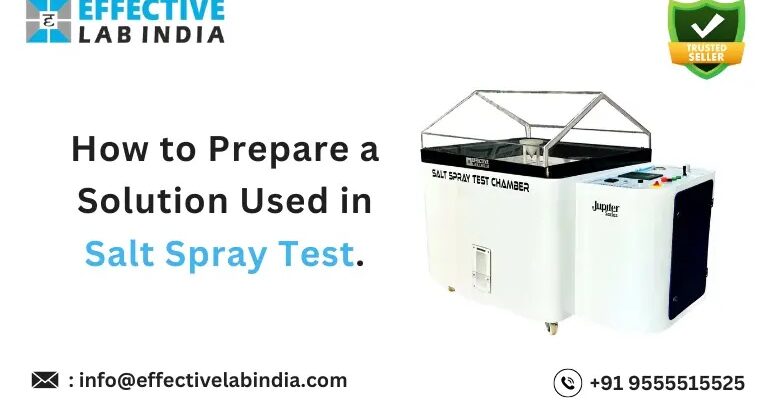
Preparing a salt solution for use in a salt spray chamber is an essential part of corrosion testing. To guarantee accurate and trustworthy test results, the solution must be precisely prepared and formulated. So, for this, understanding how to properly prepare a salt solution is crucial, whether you’re doing quality control testing or investigating a material’s resistance to corrosion.
When it comes to making a salt solution for more efficient product testing, Effective Lab will love to assist you. To help you perform successful salt spray tests on the materials, we will go over the essential stages and factors to prepare a salt solution that meets the requirements of a salt spray chamber. But before this, you should know about coatings that can be tested in a salt spray test chamber.
Coatings that can Tested in Salt Spray Test
The following coatings can be tested by Effective Lab’s salt spray test chambers.
- Steel surfaces covered in paint.
- electroplated coatings on yellow chromate
- Bolts with zinc flake coating
- coatings on surfaces
This top-notch lab testing instrument makes it simple to test these various coatings. You can get in touch with us if you want some quick information about the coatings that can be examined in a salt spray testing chamber. Let’s now talk about how important it is to prepare the salt solution before testing the metals with salt spray.
Importance of Preparing Salt Spray Solution
For accurate and consistent results in the field of salt spray testing, an appropriate salt solution must be carefully prepared. The corrosive medium in the salt spray chamber is a salt solution, also known as a saline solution, which is made up of water and sodium chloride (salt). This solution provides the necessary conditions for performing corrosion tests. This section explores the importance of carefully creating a suitable salt solution and how it affects the validity and reliability of the results of salt spray tests.
Precision in testing results
The main justification for correctly preparing a salt solution is to guarantee the precision of test results. The content of salt directly influences the degree and rate of corrosion on test samples. Excessive or insufficient concentration imbalances might produce outcomes that are not consistent with real-world circumstances.
Consistency
Another essential component in making an appropriate salt solution is consistency. Maintaining a constant concentration throughout every testing cycle is necessary to obtain reliable and consistent outcomes. The results of tests can be significantly impacted by concentration changes.
Steps of Preparing a Salt Spray Solution
A precise preparation of salt solution is essential for several uses, such as filling a reservoir tank. Following exact instructions guarantees the accuracy of results, whether you’re doing corrosion testing or other industrial procedures. This article covers the simple technique of making a salt solution for your reservoir tank, including important details like salt concentration, impurity levels, pH control, and filling instructions. Properly formulating your salt solution increases accuracy and efficiency in your operations.
1. Sodium chloride dissolves
To commence, dissolve 5±1% of sodium chloride by weight in 95% of distilled water or water with a total solids concentration of no more than 200 ppm.
2. Choose the Right Salt
Select sodium chloride that is less than 0.1% sodium iodide and less than 0.3% total impurities on a dry basis, and that is largely free of nickel and copper.
3. Preserve the pH Range
To get the best results, make sure the pH of the solution is between 6.5 and 7.2.
4. Strain the Remedy
To ensure purity and clarity, strain the prepared salt solution using a sponge filter before transferring it to the reservoir.
5. Filling by Hand
Slide the Reservoir Tank lid open. It is located just beneath the Air Pressure Control Panel. Using a beaker, carefully pour the solution into it to ensure a precise and controlled pour.
6. Optional External Tank Filling
As an alternative, you can use an external solution tank (under the customer’s scope) that is at least nine feet high. Fill the reservoir tank by connecting the M8 PU Pipe to the Salt Solution Inlet Port, which will increase filling flexibility.
Following these instructions, you can easily prepare a salt solution and conduct the salt spray test. If you would like to get more info on salt spray tests such as its latest price, specifications or something else, then you can contact us at +91 9555515525 or email us at info@effectivelabindia.com.










